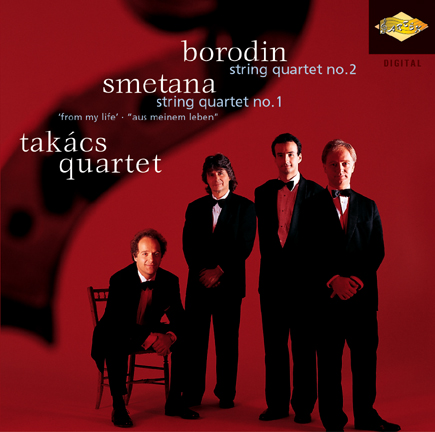ARTEK Recordings
Contents of CD12 Booklet

Click to Order Recording

ARTEK Recordings
 Click to Order Recording |

|
Bedrich Smetana:
String Quartet no.1 in E minor 'From my
life'
Alexander Borodin:
String Quartet no.2 in D
major.
Smetanaąs String Quartet no.1 in Eminor, composed in 1876 is the
first
example of a consistently programmatic work for string quartet.
Smetana
described it in a letter to J. Srb/Deebrnov dated 12th April 1878. He
did
not wish to write a string quartet along conventional lines, but rather
to
allow the autobiographical material to dictate the design. Smetana
wanted
the quartet to represent the course of his life, and in particular the
onset
of his deafness, with which he struggled from 1874 onwards. Nonetheless
the
piece does conform to a standard four movement scheme.
Smetana
describes the first movement as depicting a love of art in his
youth, an
unspoken romantic yearning and a premonition of his approaching
deafness and
misery. The second movement OQuasi Polkaą refers to the more
carefree days of
his youth, when he composed many dances and loved to dance
himself. The third
movement OLargo Sostenutoą portrays his first idyllic
love for the young
girl who later became his wife. In the fourth movement
the composer rejoices
at the advancement of Bohemian national music, until a
sudden high E harmonic
in the first violin announces the coda; the harmonic
represents the
high-pitched noise in his ear and the beginning of his
deafness. The coda
contains a recollection of happier days which gives way
to resignation at his
sad future. The idea is sometimes expressed that music
with a program of this
sort is necessarily limited, but in Smetanaąs quartet
the program seems to
lead to extraordinary dramatic intensity.
Borodinąs String Quartet no.2
[1881] is also programmatic to an extent.
Borodin dedicated the quartet to
his wife Ekaterina, and the music evokes
the early period of their romance.
The sunny expansiveness of the first
cello melody and its answer in the first
violin, is maintained through much
of the quartet, and makes a sharp contrast
to the tragic intensity of
Smetanaąs quartet. The quality of yearning and
tenderness in the first and
third movements never approaches the strife and
despair in Smetanaąs
writing. The cello features prominently in the quartet;
Borodin was himself
a keen cellist, and we can imagine that the violin
responses to the cello
melodies in the first and third movements represent
his wife.
The second movement is a delightful, fleeting scherzo
reminiscent of
Mendelssohn, with a deliciously lilting second theme. The
opening of the
famous Notturno is wistful, but this famous theme is treated
in many
different keys and registers, covering a range of emotion from
melancholy to
the ecstatic. The opening of the fourth movement has a similar
pyschological
progression to the last movement of Beethovenąs Opus 135.
Mysterious
questions give way to a chirpy, chattering theme which the
different
instruments throw around with great abandon.
Edward
Dusinberre
The Takács Quartet
The Takács Quartet was
formed in 1975 in Budapest and since 1985 has been
Quartet in Residence at
the University of Colorado, Boulder. As well as
performing over ninety
concerts worldwide each season, the Quartet is
well-known for its recordings,
winning a Gramophone Award for the complete
Bartok Quartets and Grammy
nominations for the Bartok and Schubert Trout
Quintet cds. The Quartet has
recorded works by Haydn, Mozart, Brahms,
Schubert, Dvorak, Borodin, Smetana
and Chausson on the Decca label, and is
currently recording the entire
Beethoven quartet cycle.
Photo: Steve J. Sherman
BEDRICH SMETANA 18241884
String Quartet No.1 in E minor "Z mého
zťivota"
"From my life" · "De ma vie" · "Aus meinem Leben"
mi mineur · e-Moll · mi minore
1 I Allegro vivo appassionato
6.46
2 II Allegro moderato ŕ la Polka 5.17
3 III Largo
sostenuto 7.41
4 IV Vivace 5.38
ALEXANDER BORODIN
18331887
String Quartet No.2 in D major
ré majeur · D-Dur
· re maggiore
5 I Allegro moderato 7.51
6 II Scherzo:
Allegro 4.25
7 III Notturno: Andante 7.00
8 IV Finale:
Andante Vivace 6.51
TAKÁCS QUARTET
Edward
Dusinberre violin
Károly Schranz violin
Roger Tapping
viola
András Fejér cello
Producer: Christopher
Pope
Recording engineers: Simon Eadon, Philip Siney
Recording editor:
Timothy Bull
Recording location: Evangelische Kirche, Honrath, Germany, 28
November - 1
December 1995
This recording was monitored on B & W
Loudspeakers
Art direction: David Chase
CP2002 ARTEK, All rights
reserved. Unauthorized duplication is a violation
of applicable
laws.
Licensed from Decca Music Group Limited, a division of Universal
Music
Group.
First released by London/Decca in 1996.
Printed in USA
· Made in USA
CP2002 ARTEK
® 1996 The Decca Record Company
Limited, London
© 1996 The Decca Record Company Limited,
London
Licensed from Decca Music
Group Limited, a division of
Universal Music Group.
Cover: Takács Quartet
Photo: Nick
White
CD is made in USA
Printed in USA. Made in USA
![]()